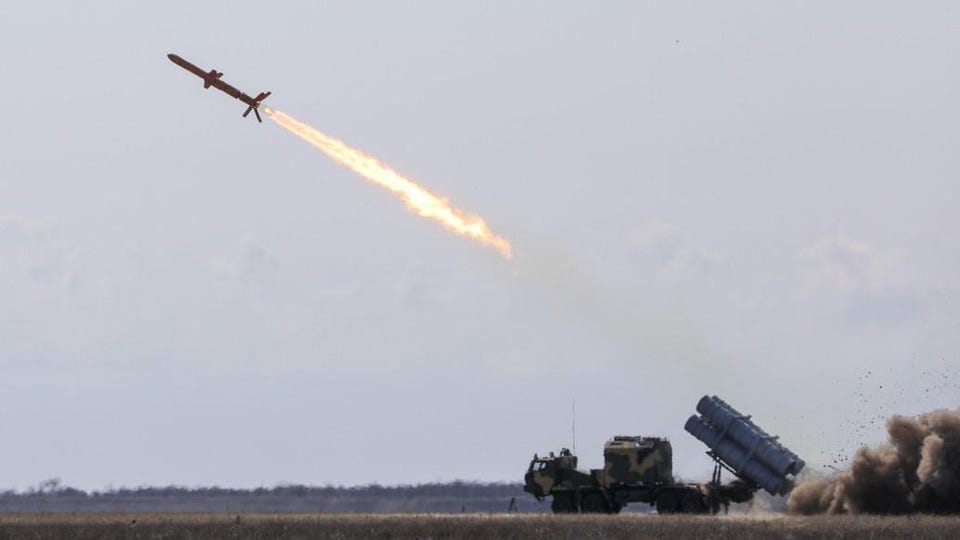Aerospace & Defense Ukraine Is Blasting Russia’s Offshore Platforms On The Black Sea David Axe Forbes Staff I write about ships, planes, tanks, drones, missiles and satellites. New! Follow this author to improve your content experience. Got it! Jul 13, 2022, 08:00am EDT | Share to Facebook Share to Twitter Share to Linkedin A Neptune anti-ship missile during testing.
Ukrainian navy photo The Ukrainian navy last month struck a Russian natural-gas rig on the Black Sea. The attack on the night of June 26 damaged Tavrida , a so-called “jack-up rig” that Russian forces seized from a Ukrainian company back in 2014 during the initial phase of Russia’s ongoing war on Ukraine. The assault on Tavrida is one facet of a wider Ukrainian naval operation aimed at evicting Russian forces from the western Black Sea.
A jack-up rig is a drilling platform that can sail under its own power, extending telescoping legs down to the seafloor once it’s over a gas or oil field. With fairly short legs for a drilling rig—usually no taller than a few hundred feet—jack-up rigs tend to stick to coastal waters. Indeed, Tavrida reportedly was over the continental shelf around 70 miles south of Odessa when the Ukrainians hit it.
Notably, the Ukrainians struck the rig with one of their precious Neptune anti-ship missiles, as confirmed by video the Ukrainian armed forces’ southern command circulated on Monday. A locally-made hybrid combining the booster of an anti-air missile, a turbojet for cruising, a radar seeker and a 330-pound warhead, the truck-launched Neptune can strike targets as far away as 60 miles. The Ukrainian navy was still testing the first prototype four-round Neptune launcher when Russian forces attacked on Feb.
23. That launcher apparently survived. It, or some additional launcher Kyiv’s engineers managed to assemble, dramatically joined the conflict on April 13, when a pair of the one-ton Neptunes holed and later sank the missile cruiser Moskva , the flagship of the Russian Black Sea Fleet.
MORE FROM FORBES VETTED 21 Amazon Prime Day Robot Vacuum Deals That Are Already Live By Sholeen Damarwala Forbes Staff 36 Prime Day Competitor Sales With Way Better Deals Than Amazon By Ciannah Gin Forbes Staff The Ukrainian fleet, which no longer possesses a single major surface combatant, has expanded its missile arsenal with new and used launchers for Harpoon anti-ship missiles that the United States and Denmark donated. But it was a Neptune that struck Tavrida on June 26, leaving a hole in the platform’s helipad. Tavrida apparently was abandoned at the time.
The more recent attack actually was a follow-up to an earlier strike. Ukrainian forces first attacked Tavrida on June 20 as part of a wider raid also targeting two other rigs. That attack destroyed one rig and damaged the other two, including Tavrida .
Several of the roughly 100 people aboard the rigs were hurt or went missing during the raid, according to Russian state media. The crews later evacuated the rigs and Chernomorneftegaz, the Crimea-based oil and gas company that operates the rigs, shut them down. Just as Russia wages a form of economic warfare by occupying Ukrainian fields and blockading ships carrying Ukrainian grain, Ukraine strikes back by impeding Russia’s Black Sea gas production.
But there were reports the Russian military had weaponized Tavrida by equipping it with Neva surface-search radars and T. V. cameras, transforming it into an offshore observation platform capable of monitoring vessels sailing from Odesa, Ukraine’s biggest port.
In that sense, Tavrida was a legitimate military target as well as an economic target. The Ukrainian military since April has mounted an intensive naval counteroffensive in the waters between Odesa and Snake Island, 80 miles south of the port. Besides sinking Moskva , the Ukrainians also destroyed or damaged—using missiles, drones and artillery—several support ships, landing craft and patrol boats and, on June 30, finally blasted the Russian occupiers off Snake Island.
In gradually pushing Russian ships east toward Crimea, the Ukrainian navy has created a tenuous safe zone in the westernmost fringe of the Black Sea. Now more and more cargo ships are lining up to access Ukraine’s grain ports on the Danube River near Romania, just 20 miles inland from the Black Sea. Follow me on Twitter .
Check out my website or some of my other work here . Send me a secure tip . David Axe Editorial Standards Print Reprints & Permissions.
From: forbes
URL: https://www.forbes.com/sites/davidaxe/2022/07/13/the-ukrainians-are-blasting-russias-offshore-platforms-in-the-black-sea/



